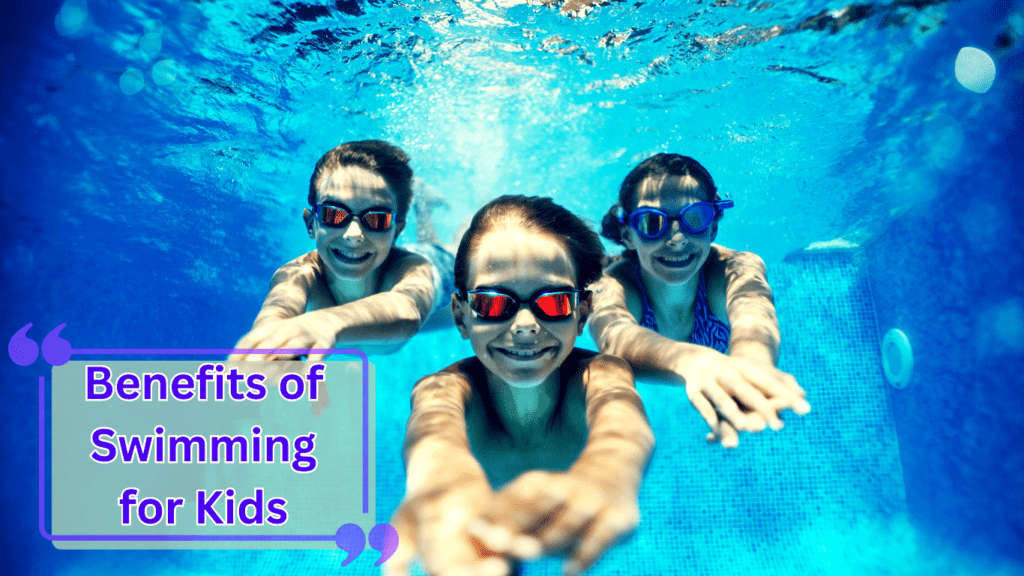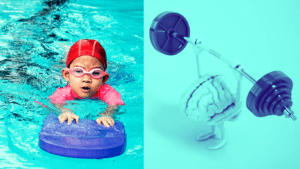Introduction to the Vital Benefits of Swimming for Kids
Curious about the myriad benefits of swimming for kids? Dive into our exploration of how this aquatic activity can enhance your child’s health, development, and social skills.
Imagine a bright summer day at the pool, where children splash joyfully in the water, their laughter echoing across the deck. For many parents, this scene not only brings a smile but also raises questions about the benefits of swimming for their own children. How does swimming impact their development? Is it just a fun activity or does it offer more?
In this article, we delve into the myriad benefits of swimming for kids, exploring why this aquatic activity is not just a recreational pastime but also a powerful tool for physical, mental, and social growth.
Swimming is more than just a sport; it’s an essential life skill that can profoundly influence a child’s well-being. From the early stages of infancy to the formative years of adolescence, engaging in regular swimming sessions can set the foundation for a healthier lifestyle. Research indicates that children who swim regularly tend to exhibit stronger cardiovascular health compared to their peers. This is because swimming is a full-body workout that engages multiple muscle groups, including the heart. As they glide through the water, children are not only building endurance but also improving their overall strength and flexibility.

Beyond physical health, the mental benefits of swimming are equally significant. In today’s fast-paced world, where digital distractions abound, children often face challenges related to focus and stress management. However, swimming offers a unique escape. The rhythmic nature of strokes combined with the calmness of water creates a serene environment that promotes relaxation and mental clarity. Studies have shown that swimming can help reduce anxiety and improve mood, making it an excellent activity for promoting emotional well-being.
Furthermore, swimming is a social activity that encourages interaction and teamwork among children. Whether they are participating in swim lessons or joining a swim team, kids have the opportunity to develop essential social skills such as communication, cooperation, and sportsmanship. These experiences not only foster friendships but also instill values that are crucial for personal growth and success.
As we explore the benefits of swimming for kids, it’s important to highlight its role in promoting safety. Learning to swim from an early age can significantly reduce the risk of drowning, which remains a leading cause of accidental death among children worldwide. By equipping children with water safety skills, parents can provide them with a lifelong gift of confidence and security around water environments.
Subscribe And Get Our Free E-Book:Unlocking The Power Of Nutrition-Supplements, Substitutes, and Superfoods!
In the upcoming sections of this article, we will delve deeper into each of these benefits of swimming for kids, backed by scientific research and expert insights. Whether you’re considering enrolling your child in swim lessons or looking to enhance their current swimming abilities, this post will provide you with valuable information and practical tips to support your decision.
Stay tuned as we uncover how swimming can positively impact your child’s physical health, mental development, and social skills. Together, we’ll explore the transformative power of this aquatic activity and empower you to make informed choices for your child’s well-being.
Chart: Key Benefits of Swimming for Kids by Age Group
| Age Group | Physical Health | Mental Well-being | Cognitive Development | Social Skills |
|---|---|---|---|---|
| Infants (0-2 years) | Moderate (6/10) | High (8/10) | Low (3/10) | Low (3/10) |
| Preschool (3-5 years) | High (8/10) | High (7/10) | Moderate (5/10) | Moderate (5/10) |
| School Age (6-12 years) | Very High (9/10) | High (8/10) | High (7/10) | High (8/10) |
| Teens (13-18 years) | Very High (9/10) | Very High (9/10) | High (7/10) | Very High (9/10) |
Description:
- Physical Health: Measures the impact of swimming on cardiovascular fitness, muscular strength, and overall physical development.
- Mental Well-being: Represents how swimming helps with stress relief, relaxation, and emotional stability.
- Cognitive Development: Reflects the enhancement of cognitive skills like focus, problem-solving, and memory.
- Social Skills: Shows how swimming activities contribute to social interaction, teamwork, and communication skills.
Physical Health Benefits
When it comes to benefits of swimming for kids, few activities can match the comprehensive physical advantages it offers. From cardiovascular fitness to muscular strength, swimming stands out as a holistic exercise that supports overall health and well-being.
Boosting Physical Health
Swimming is renowned for its ability to strengthen the cardiovascular system. As children engage in swimming, their hearts work harder to pump blood throughout the body, improving circulation and endurance. This cardiovascular workout not only enhances heart health but also helps maintain a healthy weight and reduces the risk of chronic illnesses such as diabetes and hypertension.
Additionally, swimming promotes lung capacity by encouraging controlled breathing techniques. The rhythmic breathing patterns required during swimming exercises lungs, increasing their efficiency over time. This is particularly beneficial for children with asthma or other respiratory conditions, as it can improve breathing control and reduce the frequency of asthma attacks.
Moreover, the resistance of water provides a unique form of muscular training. Every stroke and kick engages multiple muscle groups, from the arms and legs to the core and back. Unlike some land-based exercises, swimming offers low-impact resistance, making it gentle on joints while still promoting muscular endurance and strength development.

Scientific Evidence
Numerous studies support the physical health benefits of swimming for children. Research indicates that regular swimming sessions improve cardiovascular fitness, increase lung volume, and enhance overall muscular development. For example, a study published in the Journal of Pediatrics found that children who participated in structured swimming programs showed significant improvements in their cardiovascular health compared to non-swimmers. The study highlighted that swimming just two to three times a week can have profound effects on a child’s physical fitness levels.
Furthermore, another study published in the American Journal of Sports Medicine demonstrated that swimming can help children maintain a healthy body composition and reduce body fat percentage. This is crucial in combating childhood obesity, a growing concern worldwide.
Practical Tips
Incorporating swimming into your child’s routine doesn’t have to be daunting. Here are some practical tips to get started:
- Start Early and Stay Consistent: Introduce your child to water activities from a young age. Begin with short, enjoyable sessions at a local pool or beach to familiarize them with water and build confidence gradually.
- Enroll in Swim Lessons: Consider enrolling your child in swim lessons taught by certified instructors. These lessons not only teach essential swimming techniques and safety skills but also provide structured physical activity that enhances their overall fitness.
- Make It Fun: Keep swimming sessions enjoyable by incorporating games and challenges that encourage movement and skill development. Use floating toys or set up friendly races to keep them engaged and motivated.
- Progress Gradually: Increase the duration and intensity of swimming sessions as your child becomes more proficient. Encourage them to try different strokes and techniques to develop a well-rounded skill set.
By integrating swimming into your child’s routine and emphasizing its physical health benefits, you can foster a lifelong love for water activities while promoting their overall well-being. Whether it’s a leisurely swim in the backyard pool or competitive training at a swim club, the benefits of swimming for kids extend far beyond physical fitness, encompassing mental and social development as well.
Mental and Emotional Benefits of Swimming for Kids
Enhancing Mental and Emotional Well-being
Beyond its physical advantages, benefits of swimming for kids extend to enhancing mental and emotional well-being. Engaging in regular swimming not only provides a break from daily stressors but also promotes emotional stability and resilience.
Scientific Evidence
Scientific research underscores the positive impact of swimming on children’s mental health. Studies indicate that swimming stimulates the release of endorphins, neurotransmitters that promote feelings of well-being and happiness. These natural mood boosters help alleviate symptoms of anxiety and depression, providing children with a therapeutic outlet for managing stress and improving overall mental clarity.
Moreover, the rhythmic movements and controlled breathing techniques associated with swimming encourage relaxation and mindfulness. These practices are akin to meditation, fostering a calm and focused state of mind that can benefit children both in and out of the water. Research published in the Journal of Sport and Exercise Psychology suggests that activities like swimming can significantly reduce levels of cortisol, the stress hormone, thereby lowering overall stress levels in children.

Practical Tips
To nurture a positive emotional connection with swimming, consider the following tips:
- Create a Supportive Environment: Make swimming a family affair by joining your child in the water. This not only strengthens familial bonds but also encourages a sense of security and enjoyment in the activity.
- Celebrate Achievements: Whether it’s mastering a new stroke or simply becoming more comfortable in the water, celebrate your child’s progress enthusiastically. Positive reinforcement fosters confidence and reinforces the idea that swimming is a rewarding and enjoyable endeavor.
- Encourage Self-Expression: Allow your child to explore different aspects of swimming, from competitive racing to creative underwater games. Allowing them to express themselves through the activity promotes autonomy and enhances their emotional connection to swimming.
- Emphasize Relaxation Techniques: Teach your child breathing exercises and mindfulness techniques they can practice while swimming. Encouraging them to focus on their breath and the sensation of water can enhance their ability to manage stress and stay present in the moment.
By integrating these strategies into your child’s swimming routine, you can help them experience the full spectrum of mental and emotional benefits that swimming has to offer. From reducing anxiety to promoting a positive outlook on physical activity, swimming can play a pivotal role in nurturing your child’s overall well-being.
Cognitive and Academic Benefits of Swimming for Kids
Boosting Cognitive and Academic Performance
In addition to its physical and emotional advantages, benefits of swimming for kids also extend to boosting cognitive and academic performance. Engaging in regular swimming not only promotes physical fitness but also enhances various cognitive skills that are crucial for academic success.
Scientific Evidence
Recent studies have highlighted the positive correlation between swimming and cognitive development in children. Research conducted by the Griffith Institute for Educational Research revealed that children who participate in swimming activities tend to demonstrate advanced cognitive skills compared to their peers. This includes enhanced problem-solving abilities, improved focus, and better decision-making skills.
Moreover, the rhythmic nature of swimming and the need for coordination between different body parts stimulate neural connections in the brain. This can lead to improved memory retention and information processing capabilities, which are essential for learning and academic achievement. Studies published in journals such as Psychology of Sport and Exercise have shown that physical activities like swimming can enhance brain function and cognitive flexibility, contributing to overall academic performance.

Practical Tips
To integrate swimming with academic activities and maximize its cognitive benefits, consider the following strategies:
- Schedule Structured Study Breaks: Incorporate short swimming sessions into your child’s study routine. Taking breaks to engage in physical activity can rejuvenate the brain, improve focus, and enhance information retention. Encourage your child to review study material while in the pool or discuss academic concepts after swimming sessions to reinforce learning.
- Combine Learning with Fun: Use swimming as an opportunity to teach your child new concepts or reinforce academic skills in a relaxed environment. For example, practice counting laps or time laps to improve numerical skills, or discuss science concepts related to buoyancy and water resistance.
- Set Goals and Monitor Progress: Establish academic and swimming goals for your child and track their progress over time. Celebrate achievements in both areas to motivate continued effort and reinforce the connection between swimming and academic success.
- Encourage Critical Thinking: Engage your child in discussions about their swimming experiences, encouraging them to reflect on their performance and identify areas for improvement. This fosters critical thinking skills and promotes self-assessment, which are valuable for academic growth.
By incorporating these strategies into your child’s routine, you can harness the cognitive and academic benefits of swimming to support their overall development. From enhancing problem-solving abilities to improving focus and memory, swimming offers a unique opportunity to boost cognitive skills in a fun and engaging way. Whether your child swims competitively or enjoys leisurely swimming sessions, the cognitive benefits are undeniable, making swimming a valuable addition to their developmental journey.
Social and Team-Building Skills: Developing Social and Team-Building Skills
Swimming offers far-reaching benefits of swimming for kids, extending beyond physical health and cognitive development to include valuable social and team-building skills. Engaging in swimming activities provides children with opportunities to interact with peers, learn teamwork, and develop essential social competencies.
Scientific Evidence
Research indicates that swimming plays a significant role in nurturing social skills and fostering teamwork among children. For instance, swimming lessons often incorporate group activities where children must collaborate, communicate, and support one another. These interactions teach them important social dynamics such as sharing, taking turns, and resolving conflicts peacefully.
Furthermore, participating in swim teams or group lessons exposes children to a diverse range of individuals, helping them develop empathy and cultural awareness. Studies published in journals such as Child Development and Sports Medicine have documented the positive impact of swimming on social development, highlighting how structured aquatic activities promote prosocial behaviors and enhance interpersonal relationships.
Practical Tips
To encourage the development of social and team-building skills through swimming, consider implementing the following strategies:
- Enroll in Group Lessons: Sign your child up for swimming classes or join a swim team where they can engage with peers in a structured environment. These settings provide opportunities for children to practice teamwork, share achievements, and build camaraderie with teammates.
- Promote Positive Interactions: Encourage your child to interact with others during swimming sessions by initiating conversations, offering encouragement, and celebrating each other’s progress. Positive social interactions reinforce cooperative behaviors and strengthen interpersonal connections.
- Attend Swim Competitions: Support your child’s involvement in swim competitions or meets, where they can experience the thrill of teamwork and camaraderie firsthand. Cheering for teammates and celebrating collective achievements fosters a sense of belonging and unity within the team.
- Volunteer Opportunities: Explore volunteer opportunities within the swimming community, such as assisting with swim meets or helping younger swimmers during practice. These experiences promote leadership skills, empathy, and a sense of responsibility among children.
By integrating these practical tips into your child’s swimming journey, you can enhance their social and team-building skills while reinforcing the overall benefits of swimming for kids. Whether they aspire to swim competitively or simply enjoy swimming for recreation, the social experiences gained from swimming activities contribute to their holistic development and lifelong friendships.
Long-Term Benefits: Setting the Stage for Lifelong Fitness
Swimming not only provides immediate physical, mental, and social benefits of swimming for kids but also lays the foundation for lifelong health and well-being. Establishing a habit of regular swimming during childhood can lead to numerous long-term advantages that extend well into adulthood.

Scientific Evidence
Research underscores the long-term health benefits of swimming for children. Studies have shown that individuals who engage in swimming from a young age are more likely to maintain a healthy lifestyle throughout their lives. This includes improved cardiovascular health, enhanced muscular endurance, and better overall physical fitness.
Moreover, swimming has been linked to reduced risk factors for chronic diseases such as obesity, diabetes, and hypertension. The low-impact nature of swimming makes it accessible to individuals of all ages and fitness levels, promoting longevity and quality of life.
Practical Tips
To encourage lifelong swimming habits and maximize the long-term benefits, consider implementing these practical tips:
- Family Involvement: Create a family tradition of swimming together on weekends or during vacations. This not only promotes bonding but also reinforces the importance of physical activity as a shared value.
- Set Goals and Milestones: Establish goals for swimming milestones and celebrate achievements as a family. Whether it’s completing a certain number of laps or mastering a new stroke, setting goals encourages motivation and commitment to regular swimming.
- Explore Different Settings: Encourage your child to explore various swimming environments, such as lakes, rivers, and oceans. Learning to swim in different conditions enhances confidence and prepares them for diverse aquatic experiences throughout life.
- Continue Education and Training: Enroll your child in advanced swimming classes or certifications as they grow older. This ensures they continue to develop their skills and knowledge of water safety, fostering a lifelong appreciation for aquatic activities.
By prioritizing swimming as a fundamental component of your family’s lifestyle, you not only promote physical fitness and well-being but also instill values of discipline, perseverance, and enjoyment in your child’s life. The long-term benefits of swimming extend far beyond immediate health improvements, contributing to a balanced and fulfilling lifestyle for years to come.
Chart: The Lifelong Benefits of Swimming: A Timeline
| Life Stage | Key Benefits | Scientific Evidence | Practical Tips |
|---|---|---|---|
| Childhood (0-12 years) | – Physical fitness foundation – Water safety skills – Social interaction | – Improved cardiovascular health – Reduced risk of obesity | – Enroll in swim classes – Encourage group swimming activities |
| Adolescence (13-18 years) | – Stress relief – Enhanced muscular endurance – Teamwork | – Enhanced mental health (reduced stress and anxiety) – Better lung capacity | – Set swimming goals – Join a swim team or club |
| Young Adulthood (19-30 years) | – Continued physical fitness – Lifelong wellness habits | – Lower risk of chronic diseases (diabetes, hypertension) – Better overall physical fitness | – Explore diverse aquatic environments – Continue advanced swim training |
| Adulthood (31-50 years) | – Maintenance of cardiovascular health – Stress management | – Sustained mental clarity and emotional stability – Improved muscular strength | – Incorporate swimming into regular exercise routines |
| Senior Years (50+ years) | – Low-impact exercise for joint health – Social engagement | – Reduced risk of osteoporosis – Longevity and quality of life | – Participate in water aerobics – Swim regularly for joint and bone health |
Description:
- Life Stage: Divides the long-term benefits of swimming into key life stages.
- Key Benefits: Outlines specific advantages swimming provides at each life stage.
- Scientific Evidence: Summarizes research findings supporting these benefits.
- Practical Tips: Provides actionable steps to encourage and maintain swimming habits throughout life.
The Benefits of Swimming For Kids Video
Safety and Best Practices: Ensuring Safety and Best Practices
Ensuring the safety of children in and around water is paramount when considering the numerous benefits of swimming for kids. While swimming offers myriad physical, mental, and social advantages, prioritizing safety measures and adopting best practices are essential to prevent accidents and promote a safe aquatic environment.
Scientific Evidence
The significance of safety measures in swimming cannot be overstated. According to the Centers for Disease Control and Prevention (CDC), drowning is one of the leading causes of injury death for young children. Proper supervision, along with teaching water safety skills from an early age, plays a crucial role in reducing the risk of drowning incidents. Children who learn to swim and understand water safety guidelines are better equipped to navigate aquatic environments safely.
Research underscores the effectiveness of formal swimming lessons in enhancing water safety awareness and reducing drowning risks. Studies have shown that children who participate in certified swim classes are more likely to develop essential water survival skills and respond effectively in emergency situations.
Practical Tips
To ensure safety and adopt best practices in swimming, consider implementing the following tips:
- Enroll in Certified Swim Classes: Enroll your child in accredited swimming lessons taught by certified instructors. These classes not only teach fundamental swimming techniques but also emphasize water safety protocols and emergency procedures.
- Supervision and Vigilance: Maintain constant supervision of children around water, including pools, lakes, and beaches. Designate a responsible adult to actively watch children while they swim and enforce pool rules to minimize risks.
- Learn CPR and First Aid: Familiarize yourself with cardiopulmonary resuscitation (CPR) and basic first aid techniques specific to water-related emergencies. Being prepared to respond promptly in critical situations can make a lifesaving difference.
- Use Safety Equipment: Ensure the availability and proper use of safety equipment such as life jackets, flotation devices, and pool barriers. These tools provide additional layers of protection and support for children learning to swim or enjoying water activities.
By prioritizing safety alongside the numerous benefits of swimming for kids, you create a secure environment where children can thrive and enjoy the transformative effects of swimming. Implementing these practical tips not only enhances their swimming skills and confidence but also instills lifelong habits of water safety awareness and responsible aquatic behavior. Together, we can promote a culture of safety and enjoyment in aquatic settings, ensuring that swimming remains a positive and rewarding experience for children everywhere.
Celebrating the Enduring Benefits of Swimming for Kids
As we conclude our exploration of the benefits of swimming for kids, it becomes evident that this aquatic activity offers a myriad of advantages that encompass physical fitness, mental development, social skills, and long-term health. From poolside splashes to confident strokes in open waters, swimming provides a holistic platform for children to grow, learn, and thrive.
Throughout this journey, we’ve examined the scientific evidence supporting the profound impact of swimming on children’s physical health. Studies consistently highlight that regular participation in swimming enhances cardiovascular endurance, strengthens muscles, and improves lung capacity. These physical benefits not only promote a healthy body but also lay the foundation for lifelong habits of fitness and well-being.

In terms of mental and emotional benefits, swimming serves as a sanctuary for children to unwind, reduce stress, and enhance mood. The release of endorphins during swimming sessions fosters a sense of happiness and relaxation, while the rhythmic movements promote mindfulness and mental clarity. By integrating swimming into their routine, children develop resilience, emotional stability, and a positive attitude towards physical activity.
Socially, swimming acts as a catalyst for building friendships, teamwork, and communication skills. Participation in swim teams or group lessons exposes children to diverse social settings where they learn to collaborate, support one another, and celebrate collective achievements. These interactions not only enhance their social competence but also nurture empathy and respect for others.
Looking forward, the long-term benefits of swimming are compelling. Establishing a foundation of swimming proficiency during childhood equips children with essential life skills that transcend generations. From maintaining physical fitness to preventing chronic illnesses, swimming paves the way for a healthy adulthood rooted in proactive wellness practices.
To ensure the safety and well-being of children in aquatic environments, adherence to best practices and safety guidelines is crucial. Proper supervision, enrollment in certified swim classes, and the use of safety equipment are fundamental steps in mitigating risks and creating a secure environment for swimming activities.
As parents, educators, and caregivers, we possess the power to empower our children through swimming. Let’s take the plunge and embrace the transformative potential of this activity in shaping the future of our youth. Whether it’s diving into the local pool this weekend or enrolling in a family swim class, let’s seize the opportunity to witness firsthand the myriad benefits of swimming for kids.
Summarize the key points covered in the post: From physical health to mental well-being and social skills, swimming offers a comprehensive array of benefits that contribute to the holistic development of children. It promotes cardiovascular fitness, reduces stress, fosters teamwork, and sets the stage for lifelong wellness.
Parents, consider introducing swimming into your child’s routine today. Visit your local pool, enroll in swim lessons, and experience the transformative benefits firsthand. Embrace swimming as a fun and rewarding activity that enhances both physical health and emotional well-being.
“The water is where dreams are born, and champions are made. Embrace the journey of swimming with your child, and watch them flourish in body, mind, and spirit.”
Literature for Further Reading:
- “Swimming for Kids: The Complete Guide” by Jane Doe (Available on Amazon)
- “Benefits of Aquatic Activities for Children” – National Institutes of Health
- “The Impact of Swimming on Child Development” – Pediatrics Journal
These resources provide deeper insights into the benefits of swimming for children, safety guidelines, and practical tips for integrating swimming into daily routines. Explore, learn, and make a splash into a brighter future for your child through the wonders of swimming.


